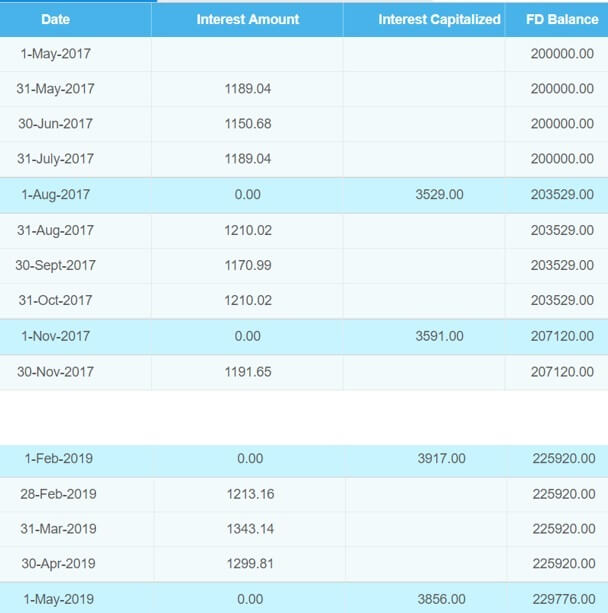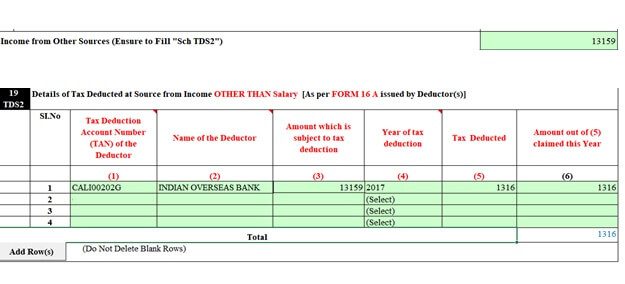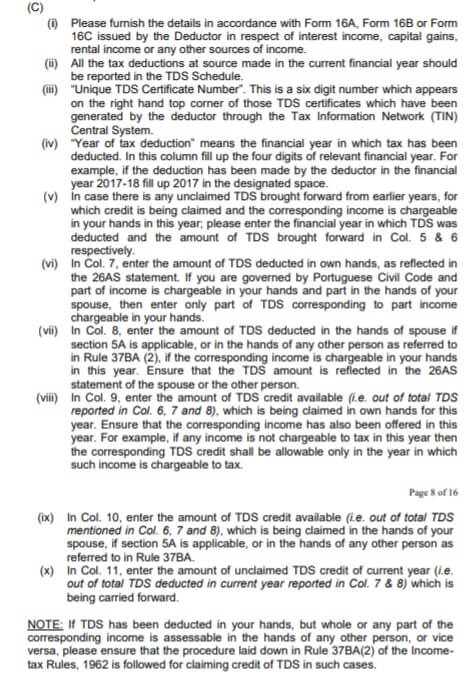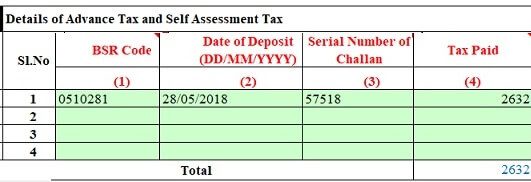Fixed Deposit (FD) is an investment product which allows you to invest a lump sum of money for a fixed period and at a fixed rate of interest. It is one of the simplest investment product with many benefits. In India, you can invest from 7 days to 10 years. Interest from FD is taxable and if above 40,000 Rs TDS is deducted(Rs 50,000 for Senior citizens). In this article, we shall see Fixed Deposit over Multiple Financial years, Details of Interest and TDS in Form 26AS, how interest and TDS have to be filled in Income Tax Return. If any extra tax due Advance or Self-Assessment Tax has to be paid.
Table of Contents
Types of FD: Simple/Cumulative or Reinvestment FD
There are different ways in which one gets interest from Fixed Deposit
- Simple FD: Interest is paid out after a fixed time, monthly or quarterly i.e. 3 months. if FD a/c was opened on 15th Feb first interest installment would be paid on 15 May
- Cumulative FD or compound interest FD or Reinvestment FD: One can have the interest reinvested in the FD account. For such deposits,
- the interest is paid with the invested amount on maturity of the deposit at the end of the term
- Interest accrued on the deposit each quarter is invested along with the principal
- Interest is calculated on total sum; net of Tax Deducted at Source (TDS)
FD Interest Rates Calculator helps to calculate interest on FD as follows:
- For fixed deposits schemes with a tenure below 6 months, interest is calculated at simple interest. Please note that the period of the Fixed Deposit is considered in a number of days.
- The Fixed Deposit rate applicable for a monthly interest option will be a discounted rate over the standard rate.
For Fixed Deposits with tenure of 6 months and above, interest is calculated on a quarterly basis.
- In case you choose to receive the periodic interest payments on a quarterly basis, interested is calculated and paid on quarterly rests.
- Interest earned during the previous quarter is added to the principal for calculation of interest. Fixed deposit interest rate on this amount is calculated every quarter.
Fixed Deposit and Tax
Interest on FD is considered as your income. You must report it as Income from Other sources.
The interest that is earned on fixed deposits is taxable in the hands of the depositor as per the income slab. So, a person who earns income between 2.5 lakh to 5 lakh pays only 5% tax on it while the person who earns above 10 lakh pays 30% tax
For a joint FD, the Tax liability is applicable to the first applicant. The second or joint holder has no tax liability.
If the interest income from fixed deposits that you are likely to earn for all your fixed deposits held in a branch is greater than Rs 40,000 in a financial year(Rs 50,000 for senior citizens), TDS will be deducted.
TDS is deducted at the rate of 10% if PAN is submitted. If PAN is not submitted TDS is deducted at the rate of 20% and then you can’t even claim it.
You can avoid TDS if you submit Form 15G(for those less than 60 years)/15H(for those above 60 years). Submission of Form 16 still doesn’t do away with the tax liability.
TDS is deducted even on interest earned but not yet paid, at the end of the financial year. If you have gone for cumulative option in FD which pays interest at maturity the interest would be earned every year and TDS (if applicable) would be deducted though you don’t get the money.
Form 16A is issued by the bank/organization which has details of TDS deducted during a financial year. TDS deducted comes up in your Form 26AS which tied to your PAN number. Details in it should match the Form 16A provided by the bank to you.
Details about the interest earned on an FD in a Financial Year appears in Form 26AS and AIS, irrespective of the amount or whether TDS was deducted or not as shown in the image below.
Fixed Deposit over Multiple Financial Years
As mentioned earlier Fixed Deposit can be done from 7 days to 10 years. Let’s understand Fixed Deposit over Multiple Financial Years with an example Say Tarak started a FD for 2 years on 1 May 2017 in cumulative/reinvestment option. He will get the invested amount (called principal) and interest on maturity only on 2 May 2017. But he has to report the interest earned in FD while filing Income Tax Return or ITR of different Financial Years.
Earlier Form 26AS did not have details of the interest of FD if no TDS is deducted but now Form 26AS shows the interest for FD even when no TDS is deducted.
Ex of interest calculation Quarter-wise is shown below
FD interest over different Financial Years
As Interest in FY 2017-18 is more than 10,000 Rs TDS will be deducted at 10% as PAN was given, though the interest amount is not credited into Tarak’s bank account. Interest along with principal will only be available on maturity.
While Filing ITR of FY 2017-18 Tarak will have to show 13,158.92 as his Income from other sources.
He also has to claim TDS deducted(if any) at 10%.
If Tarak is in higher slab than 10% then he would have to pay some more tax on the interest amount either as Advance Tax or Self-Assessment Tax
Show TDS details from FD from Form 16 or Form 26AS in ITR1
Show TDS details from FD from Form 16 or Form 26AS in ITR2 etc
Claim TDS credit in the name of Self with TAN and Name of the Bank as shown in the images below.
Claim TDS of the current Financial Year and what you are claiming this year. Please make sure that in last column TDS credit out of (6), (7) or (8) being carried forward is 0.
and the last row in TDS details has the TDS amount.
Instructions are given below.
Fill Self Assessment/Advance Tax details in ITR for interest on FD income
Assuming Tarak is in the slab of 30% than 10% then he would have to pay some more tax on the interest amount either as Advance Tax or Self-Assessment Tax using Challan 280 and enter details in ITR as shown in the image below.
While Filing ITR Tarak will have to show 15,317.38 as his Income from other sources. He would have to pay Advance/Self Assessment Tax as he is in 30% slab.
While Filing ITR of next year Tarak will have to show 1299.70 as his Income from other sources. As no TDS is deducted so he will not have to claim TDS. He would have to pay Advance/Self Assessment Tax as he is in 30% slab.
Related Articles:












Thanks, This is informative.
Would you please tell us that the tds 2 portion of Itr2 is seems to be incorrect column as in the column where to select the year on which claiming tax deducted 2017 is not showing.It is given upto 2016,why
Thanks for bringing it up.
You have to fill in TDS of the current Financial Year and claim.
We have added images for the TDS details here.